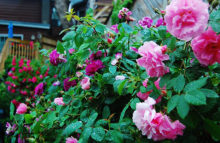I’d been gardening on it for almost 10 years before I knew these garden spaces actually had a name: The Hell Strip. And suddenly all my challenges made sense. Yep, I’ve been trying to garden on a little strip o’ hell.
For those of you unacquainted with the “hell strip” it’s a long garden space bordered on both sides by either a road or a concrete walkway. Some are obviously hell-like, in full baking sun. Mine, however, is in dappled shade, which led me to think it might be a fairly hospitable place for cultivation.
“Ha!” chuckled the dark denizens of hell as I got out my spade.
Many years ago someone had optimistically dug all the grass from the strip and had planted bulbs. These did fairly well the first year, and when I got hold of the space I had high hopes, but I soon learned what I was up against. My hell strip is shady, filled with sandy, what I laughingly call “soil”. This “soil” is filled with tree roots from oft cursed Norway maples. It’s the definition of a challenging space. Here’s what I’ve learned about my hell strip over the years:
1. Bags of manure that I pile on the strip disappear, possibly melting through the earth’s crust and showing up somewhere in Australia.
2. Lady’s Mantle, Alchemilla mollis, if planted in large drifts, with the hope that masses of flowers will frothily cascade onto the sidewalk, will actually drift away never to be seen again.
3. The surface tension of the soil has sort of a magnetic effect, and by magnetic effect, I mean the other side of the magnet that repels things. Water sprinkled onto the soil surface trips lightly over it and rushes to the safe haven of the concrete on either side.
4. Certain plants hang around. Oh, they don’t actually grow or increase, but as they’re hanging onto life, I still have hope. But every year they get a little bit smaller and a little bit smaller. They sing softly to me as I pass by, “We gotta get outa this place. If it’s the last thing we eh-ver do.”
5. Worms shun the hell strip. But snails hang around in large gangs. Hostas say: “Hosta la vista!”
There is some good news though. Here are my surprising hell strip successes:
1. Shasta daisies, Leucanthemum ‘unknoweum’, inexplicably, thrive and bloom like crazy. As you can see by the photo at left, they are spreading into a reasonable clump. I’m completely puzzled by this.
2. Rudbeckia triloba (seen in leaf at the top of the column) manages to grow and blooms faithfully at the end of every summer. Also self seeds. Yes, it’s a bit weedy, but it’s green and the flower clusters of small, yellow, black-eyed Susans on sturdy stems are cheerful when not much else is blooming.
3. Lamium maculatum (the variegated leaf shown just behind the rudbeckia, above) grows like crazy and blooms reliably through spring and early summer. Yes, it’s a bit boring, but can’t argue with that kind of success, and the leaves are attractive all year.
4. Perennial foxgloves – Digitalis lutea – manages to grow and flower, in unexpected places. This is a charming little plant (with spikes of tiny, creamy yellow foxglove flowers) that I have nothing bad to say about.
5. Columbine, Aquilegia, have planted themselves happily here and there, and for a short while in spring, look lovely.
So, my lesson here is to plant more of what works, and to rescue what’s left of the ones that are desperately singing songs of escape. Sadly, the rest of my garden is no plant picnic either: same soil, same shade. Hmm, maybe my rescues can go into the guerrilla garden across the road….






10 comments
That sounds like a lovely mix of flowers. Most of the Meridians around here suffer the same problem. I find the ones that work the best tend to be the grasses and coneflower's. Not a bad combination!
Sarah, This is my first introduction to the "Hell Strip." Fortunately, although I share your sandy "soil," there is no paving on my rural road, so I'm saved from the hell strip. I have found over the years, though, that the philosophy of just going with the plants that want to grow is a good general gardening solution. -Jean
Sarah, you brave gardener – taking on the "strip"! Sounds like you have actually found some charming winners.
"We gotta get outa this place. If it's the last thing we eh-ver do."
Hee hee! Great post!
Dry shade is the worst place to have a garden, but it sounds like you have succeeded Helen.
Helen,
This is not related to this post, but I just wanted to send you a big thank you for leaving your great advice reagrding my "mushroom attack" on my blog. I had put a picture up on my blog and had been asking around on Twitter for 2 days, then I connected with you and Sarah and actually got an answer in a really short time. Thank you so much!
I know my pot is a problem; it actually used to have a drainage hole, but I sealed it, because I thought I could avoid the ugly plant saucers. I guess that was not the best idea.
Happy gardening, Maya.
Ah, so that is what I should call that patch in my garden. Thanks for the suggestions! Strangely, the only thing that really grows there is a boxwood. It gets sun so I've started thinking vegetables.
Your list of growers is not unlike the ones selected for Buffalo gardens. I think Buffalo has taken the hell strip to a higher level than most localities. So many homeowners have adopted this sad area and made lemons out of lemonade. It is good you found a great combination of plants that have the will to live. Check out Art of Gardening, Living hell Strips for gorgeous images of hell strips, or even my post Creating Curbside Charm. If you did not see either, there are many examples, most in bright sun. You have a good post here, I enjoyed your humor.
My equivalent is immediately in front of my living room window. I need plants at the back of the border but a.) they can't be too tall or we won't be able to look out and b.) the soil there turns out to be about to be little more than a foot deep so there's no root space for tall perennials. (And dries out in two seconds.)
I've built up the soil a bit with home-made compost and loam over the years but can't go too high or it will slide onto the pavement – along with the smaller plants which do well but lean into the pathway to get nearer the sun.
I can't grow Aquilegia or Digitalis there because they are poisonous and lots of children live in the street.
This bed is in a very prominent position and a constant embarrassment!
Esther
Now I know what to call the rows in the garden after my wife gets done with them 🙂
I am lucky to say (knock on wood) that I've never had to garden a strip, hellish or not. Come to think of it, is it strange that I've never lived in a place that had sidewalks? I always send a virtual pat on the back to those who garden in hell strips. Yours actually sounds quite nice!